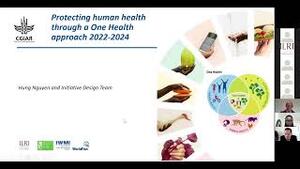
Epidemiology of antimicrobial resistance at the livestock-human interface in an urban environment: a One Health approach
Abstract
Livestock have been implicated as a reservoir for antimicrobial resistant (AMR) bacteria that may spread to humans, with the keeping of livestock widely postulated as a risk factor for AMR in humans. However, quantitative evidence of the role of livestock in the emergence and transmission of AMR bacteria to human populations is lacking. This thesis focuses on the role of livestock keeping as a potentially high-risk interface for AMR transmission between humans and livestock in urban Nairobi. To achieve this, E. coli isolates were systematically collected from sympatric human and livestock populations in 99 households across Nairobi, Kenya. E. coli was characterised both phenotypically (through antimicrobial susceptibility testing) and genetically (through whole genome sequencing). In the first part of this thesis, I conduct a comprehensive systematic review to investigate existing evidence that food animals are responsible for transfer of resistant E. coli and their AMR determinants to humans. I demonstrate that the current evidence regarding transmission of drug resistance between food animals and humans is limited and that similarity of AMR bacteria or AMR determinants in the two populations does not, by itself, provide information on directionality of transfer. I highlight the need to use high resolution genomic analysis on human and livestock bacterial samples collected in time and space to better understand the direction and frequency of AMR transmission between these populations. Next, utilising AMR phenotypes and genotypes, I explored the variation in carriage of AMR E. coli and investigated the role of livestock ownership as a risk factor for AMR carriage in humans. First, I explored the epidemiology of clinically relevant AMR phenotypes and AMR genetic markers. I detected high rates of AMR phenotypes, with 47.6% and 21.1% of isolates displaying resistance to ≥ 3 and ≥5 antimicrobial classes respectively. Whole-genome sequencing revealed 60 acquired genes and 14 point mutations conferring AMR to 9 antimicrobial classes. sul2, strA, strB, tetA, and blaTEM-1B were the most frequently detected AMR genes conferring resistance to sulfonamides, aminoglycosides, tetracyclines, and β-lactams respectively – the most commonly found phenotypes. Highest carriage of AMR genes and phenotypes was observed in humans, pigs and poultry compared to goats, rabbits and bovines. Secondly, I demonstrated that the presence of livestock in the household did not influence phenotypic or genotypic AMR carriage in humans, but the impact of keeping livestock on human AMR carriage was instead influenced by presence of animal manure in the household. Utilising high resolution sequencing data, I proceeded to investigate the patterns of bacterial relatedness and strain sharing as a proxy for transmission potential. I showed that livestock and human isolates are genetically heterogeneous, with minimal evidence of clustering by host group, and that E. coli genomes in humans did not segregate according to livestock ownership. Next, I found evidence of 91 sharing events differing by less than ten base pairs (59 involving livestock isolates only 23 human isolates only, and 9 between humans and livestock), and that most of the sharing events were confined within households with only occasional instances of spread between household. I also demonstrate that high-resolution sequence-based analysis of SNPs is more discriminatory than MLST – a widely used tool in describing transmission of E. coli. Next, I described the patterns of antimicrobial sales in humans and livestock, and the level of awareness and common behaviours related to antimicrobial prescribing amongst human and veterinary pharmacists in urban Nairobi. β- lactams, fluoroquinolones, first and second generation cephalosporins, and metronidazole were the most commonly purchased human antimicrobials while tetracyclines, sulphonamides, penicillins, and macrolides were the most commonly purchased veterinary antimicrobials. This finding was in line with the resistance phenotypes and genotypes described in this thesis. I found that whilst most pharmacists were knowledgeable about antimicrobial use and AMR, inappropriate prescribing practices were common and that over the counter sale of antimicrobials, without a prescription, was a common occurrence in both human and veterinary drug stores. In the final section of the thesis, I investigated the co-occurrence patterns of acquired AMR genes and the role of conjugative plasmids on the epidemiology of AMR spread. I found evidence of co-location of multiple AMR genes in both human and livestock isolates, potentially enabling acquisition and dissemination of multi-drug resistance phenotypes in a single step. I found a diversity of known plasmids and plasmid replicons that were associated with the distribution of acquired AMR genes. To conclude, I discuss the findings of this thesis in the context of the current epidemiology of AMR pathogens at the human-livestock interface and highlight future directions for research on AMR transmission, and discuss implications of my findings for public health. This thesis demonstrates how fine-scale genomic analysis explicitly embedded within an epidemiologically structured sampling framework can be utilized to track bacterial sharing and in the surveillance of AMR prevalence in a low income urban setting. The connectivity of bacteria and their AMR determinants between humans and livestock and the ultimate impacts upon human health lends strong support for a holistic ‘One Health’ perspective for AMR surveillance.
Citation
Muloi, D.M. 2019. Epidemiology of antimicrobial resistance at the livestock-human interface in an urban environment: a One Health approach. PhD thesis. Edinburgh, Scotland: University of Edinburgh.










